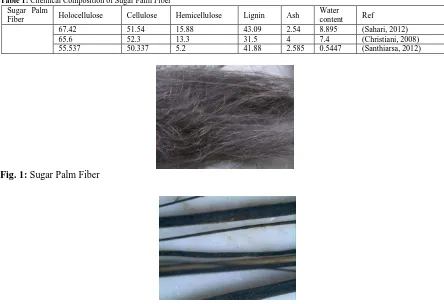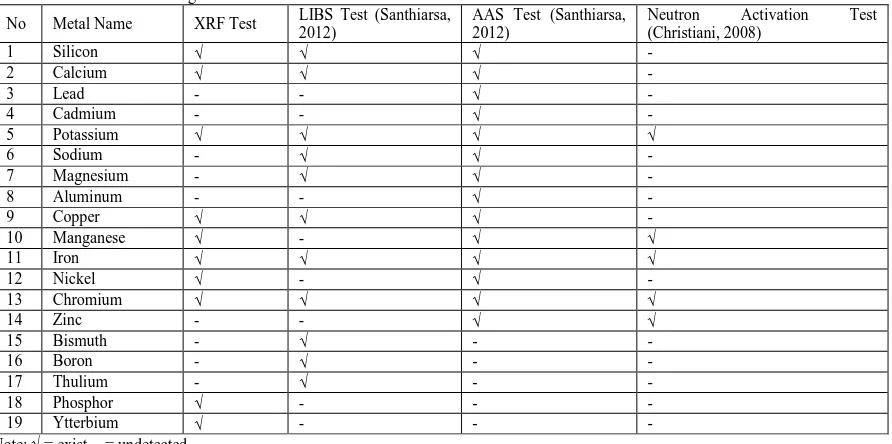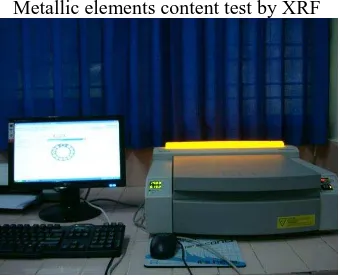Australian Journal of Basic and Applied Sciences
ISSN:1991-8178Journal home page: www.ajbasweb.com
Corresponding Author: Nitya Santhiarsa, Brawijaya University, Mechanical Engineering Department, Engineering Faculty. Malang. Country.
Phone: +62-341-587710; E-mail: teknik@ub.ac.id; Jl. Mayjen Haryono 167 Malang.
The Effect of Alkali Treatment on Metal Content In Sugar Palm Fiber
1Nitya Santhiarsa, 2Pratikto, 2Ahmad As’ad Sonief, 3Eko Marsyahyo
1Brawijaya University, Mechanical Engineering Doctorate Program, Engineering Faculty, 65145, Malang, Indonesia 2
Brawijaya University, Mechanical Engineering Department, Engineering Faculty, 65145, Malang, Indonesia 3National Institute of Technology, Mechanical Engineering Department, Engineering Faculty, Malang, Indonesia
A R T I C L E I N F O A B S T R A C T
This study is concerned with the effect of alkali treatment on a metal content of sugar palm (arenga pinnata) fiber. The alkali treatment was done by the fibers being soaked in the NaOH and KOH solutions for one hour with the concentration variation of 0.25 M and 0.5 M and without heating. Alkaline KOH solution is more robust when compared with NaOH solution; in this case, the influence of the reaction solution becomes the study parameter in addition to the level of the solution concentration. The X-Ray Fluorescence testing (XRF) was used to test the metallic elements or elementary analysis content. The XRF testing results show that the five highest metal elements contained in the fiber composition are silicon, calcium, potassium, phosphor, and iron respectively. The fiber treatment with NaOH and KOH solutions was performed with their respective concentrations of 0.25 M and 0.5 M; finally these treatment results were then being compared. It was found that the percentage of the concentration of metal elements in the fiber with 0.5 M KOH treatment was the least if compared with the other treatments. The factor of reaction power or base strength and concentration levels affect the reaction solution containing the metal element in the fiber, where the stronger alkaline and high concentration of the solution the more metal content becomes decomposed so that the one remaining in the fiber becomes less.
© 2014 AENSI Publisher All rights reserved. To Cite This Article: Nitya Santhiarsa, Pratikto, Ahmad As’ad Sonief, Eko Marsyahyo., The Effect of Alkali Treatment On Metal Content In Sugar Palm Fiber. Aust. J. Basic & Appl. Sci., 8(10): 614-619 2014
INTRODUCTION
Coulomb force and the core orbital Coulomb force, and it can be said that only neutrons interact with the atomic nuclei of the material in its path. At the same energy, neutron cross sections in the material are much smaller than the charged particles. In general, the neutron cross section is inversely proportional to its energy, so that the neutron has a greater penetrating power than the charged particles. The interaction of neutrons with materials other than depending on the neutron energy also depends on the type of material. There are several mechanisms which operate when a neutron passes through a material, namely; resilience scattering; non-resilience scattering; and capture and fission reactions. (Safiri, 2006) In the event of withstanding neutron radiation, the process needed is the one for slowing fast neutron scattering with no resilience scattering using light elements in the absorption of neutrons. Given these interactions, there will be a reduction in the intensity of neutrons; so that if possible, the good shield against neutron radiation is the one serving as a combination between materials with light elements and those with heavy elements.
To expand the utilization of palm sugar fibers in wider materials technology, especially in smart materials technology for the needs of protection against a variety of electromagnetic waves, it is necessary to do further research on the chemical properties of the elements, especially metals present in the palm sugar fibers. The effect of alkali is in the limelight as most natural fibers including palm sugar fibers before being used as filler or reinforcement in composite manufacturing processes is given a surface treatment so that its compatibility with the polymer matrix can be improved. Fiber compatibility with the polymer matrix increases due to some circumstances such as a lack of hydrophilic fibers: a fiber is cleaner; porosity and roughness of surface fibers increase, and better wettability properties of fibers, thereby making the composite get stronger. Surface treatment and chemical treatment can be done, among others, by dampening the alkaline solution, permanganate, and the use of coupling agents (Jhon, 2008). Alkaline treatment with NaOH had been much done, besides being relatively more economical also the results obtained are quite good; even so do research on treatment with alkali such as KOH to know the comparison results in a qualitative or quantitative example of the composition of the contents of heavy metals contained in the fiber. As is known, both NaOH and KOH are strong bases where KOH is more robust base compared with NaOH; stronger bases can dissolve the lignin and hemicelluloses including metal elements contained in them.
Table 1: Chemical Composition of Sugar Palm Fiber Sugar Palm
Fiber Holocellulose Cellulose Hemicellulose Lignin Ash
Water
content Ref
67.42 51.54 15.88 43.09 2.54 8.895 (Sahari, 2012)
65.6 52.3 13.3 31.5 4 7.4 (Christiani, 2008)
55.537 50.337 5.2 41.88 2.585 0.5447 (Santhiarsa, 2012)
Fig. 1: Sugar Palm Fiber
Fig. 3: Mechanism of Alkali Treatment in Fibers
Next is the reaction between natural fibers and alkali solution, NaOH and KOH: (Jhon, 2008; Zaman, 2011); -OH fibers + NaOH -ONa+ fibers + H2O
-OH fibers + KOH -OK+ fibers + H2O
The decomposition of lignin and hemicelluloses is influenced by several factors: reaction power, or in this case, the strength of bases, solution concentration, reaction time, and temperature. KOH is a stronger base than NaOH where the base strength related to the amount of OH that can be added to the water. The -OH number will be more released into the water from KOH compared to NaOH. -OH concentration will be greater in the strong alkaline solution, i.e., the stronger the base the greater the concentration of OH-in the solution. Then, the more -OH in the solution the more likely an attack on carbon cluster in palm sugar fibers so that more likely the metal content to be released together with the disintegration of lignin and hemicelluloses. The attack processes are supposedly influenced by the presence of other ions in the reaction medium such as Na + and K + ions.
Sugar palm fibers as part of the plant contain metallic elements which can be used as radiation shielding materials such as alpha, beta, and neutron radiations. Several studies have been conducted to determine the content of heavy metals found in palm sugar fibers, a study conducted by Evi Christiani (Christiani, 2008) using the neutron activation analysis method reveals that sugar palm fibers contain metallic elements such as chlorine, manganese, potassium, bromine, chromium, iron, mercury, lanthanum, and zinc. Mimpin (Sitepu et al, 2006) corroborate the fact that palm sugar fibers contain metal elements such as sodium, magnesium, silicon, aluminum, and calcium.
Table 2: Metal Contents in Sugar Palm Fiber
No Metal Name XRF Test LIBS Test (Santhiarsa, 2012)
AAS Test (Santhiarsa, 2012)
Neutron Activation Test (Christiani, 2008)
1 Silicon -
2 Calcium -
3 Lead - - -
4 Cadmium - - -
5 Potassium
6 Sodium - -
7 Magnesium - -
8 Aluminum - - -
9 Copper -
10 Manganese -
11 Iron
12 Nickel - -
13 Chromium
14 Zinc - -
15 Bismuth - - -
16 Boron - - -
17 Thulium - - -
18 Phosphor - - -
19 Ytterbium - - -
Note: = exist, - = undetected
Experimental Material:
Sugar palm fibers were obtained from Gianyar district, Bali. Alkaline solution used was a solution of sodium hydroxide (NaOH) and Potassium Hydroxide (KOH).
Study Parameters:
The parameters used in this study include fixed variable content of metal elements, namely the composition of fibers and fiber variable changed is the percentage concentration of metallic elements in the fiber content of the fibers with the power base and the level of alkaline solutions of different concentrations.
Fig. 4: NaOH and KOH powder
Specimen Preparation:
The fibers are cleaned and dried, divided into five sections, one sample without treatment, and four other samples with the treatment, i.e., one each for the treatment of 0.25 M NaOH, 0.5 M NaOH, KOH 0.25 M, and KOH 0.5 M. fibers soaked for 1 hour in a solution of alkali, respectively, after it was removed and rinsed with distilled water to clean and rinse water neutral (pH 7), and then dried in the room for 4 days. All fiber fibers then cut into small pieces or shredded then ground up into a fine powder.
Metallic elements content test by XRF
Fig. 5: XRF-Test Set up (Basic Science Lab., Malang University)
XRF Test Procedure:
Step I: XRF Tools Preparation
Turn on the XRF, Switch the HT key on (X-Ray On), turn on the computer and open the Minipal program and wait for about 10-15 minutes or until the equipment is really ready to be used.
Step II: Sample Preparation
For powder and solid samples: Prepare a holder that has been installed with a special plastic for XRF and put the sample to be tested into the holder.
Step III: Measurement
Put the sample into the XRF, in the Minipal program, open the Measure menu, Measure Standard less, Name the sample to be measured in Ident Sample and Measure (according to the order of the sample) Wait for some minutes until the measurement process is finished. To look at the result open the menu Result, <Standardless> then print the desired results.
RESULTS AND DISCUSSION
are not detected by the XRF test. Then, quantitative analysis of the five highest elements of metal in the palm sugar fibers are respectively silicon, calcium, phosphorus, potassium and their respective percentages are 43.2 %, 34.5 %, 8.4 %, 7.1 %, and 3 %. In relation to the ability of the radiation protection of high-frequency electromagnetic waves that ionize the metallic element with light atomic weight absorb neutron particles whereas metallic elements with high atomic weights can withstand gamma radiation. Metallic elements with light atomic weight, among others, are aluminum, silicon, and phosphor and those with high atomic weight are iron, nickel, and copper, then, for the protection of low-frequency electromagnetic wave radiation is not ionized, metals generally have free electrons in each atom making surface material more conductive where a conductive material reflects incoming electromagnetic waves, as is known, reflection is one of the mechanisms of a shield or protection from a material as well as absorption (Roh, 2008).
Table 3: Metal Concentration and Composition as a Result of the Alkaline Solution Treatment Effect in Sugar Palm Fiber
Metal Without Treatment NaOH Solution KOH Solution
0.25 M 0.5 M 0.25 M 0.5M alkaline solution with NaOH or KOH does not affect the composition of the metallic elements in the sugar palm fibers, if not detected, this might be due to the fact that the amount or concentration is very little if compared with the other metal contents. However, quantitatively, there are big changes in the amount or concentration of heavy metals content either due to the influence of the reaction power or the base strength of each alkaline solution where the KOH solution has the reaction power or base strength higher than that of NaOH solution or the influence from molarity concentration level (M) of alkaline solution, where the higher the concentration of the reaction solution the stronger the reaction power. As is known, the parameters such as base strength and the solution concentration level influence the process of lignin hemicelluloses decompositions in fibers also the content of metals and physically the decomposition of lignin and hemicelluloses cause the attenuation of fiber diameters and at the same time the weight of the fibers. In the Table above, if the test results between the treatments NaOH and KOH at the concentration and the same time of immersion are compared, it is generally seen that a decline in the percentage of metal element concentrations is greater in the KOH solution, this shows that more metallic elements that get decomposed by the KOH solution. This is because reaction power of KOH is stronger than that of NaOH, where the base strength of KOH is greater than NaOH. Then, it is known also that in the same solution but different concentrations, in general, there is a percentage decrease of the concentrations of metallic elements which is greater in metal solutions with higher concentrations, the cause is that the high level of concentration of the solution induces the stronger reaction power so that more and more metallic elements that get decomposed. Thus, the stronger power of the base reaction and the concentration of the solution then the more lignin and hemicelluloses which get decomposed in which the content of metal elements in them were also unrevealed.
The decrease in the percentage content of silicon concentration is quite large due to the fact that silicon belongs to group IV A in the periodic table. It is very easy to react with the alkali metal elements (group IA) so that silicon gets decomposed easily. The same is true of phosphor which belongs to VA group. Other metallic elements such as iron, manganese, copper, nickel, and chromium are less decomposed because they are harder to react if compared with the two metals mentioned above. Calcium appears to increase its percentage because relatively it does not react with the two types of alkaline solutions because they are equally classified as earth alkaline metal, while potassium increases substantially in the reaction with KOH solution; this is due to the additional sediment of potassium originating from KOH solution.
Conclusions:
and iron. Treatment of fibers was done with a solution of NaOH and KOH with respective concentration of 0.25 M and 0.5 M, then the results were compared with the percentage concentration of metallic elements in the fibers with 0.5 M KOH involves the least if compared with the other treatments. Power reaction factor or the strength of a base reaction and the concentration level of solution affects the solution reaction rate with the content of metal elements in the fiber, where the stronger alkaline and high concentration of the solution the more metal content which gets decomposed so that fewer fibers remain.
ACKNOWLEDGEMENT
We thank the Directorate of Higher Education (DIKTI) and the Ministry of Education and Culture of the Republic of Indonesia for the research funds that have been granted and also the staff of Analytic Laboratory and Common Laboratory of the Mathematics and Basic Sciences of Udayana University and the staff of Basic Laboratory of Malang University for their helps during this study.
REFERENCES
Christiani, E., 2008. Sugar Palm Fiber Characterization on a Short Sugar Palm Fiber Flat board as a Neutron Radiation Shield, Student Thesis, Physics Studies Magister Programs, Sumatera Utara University, Medan.
Jhon, M.J., et al., 2008. Recent Developments in Chemical Modification and Characterization of Natural Fiber-Reinforced Composites, Polymer Composites, Wiley Inter Science.
RCT Study Guide, 2005. Interaction of Radiation with Matter.
Roh, Jung Sim, et al, 2008. Electromagnetic Shielding Effectiveness of Multifunctional Metal Composites Fabrics, Textile Research Journal, Pro Quest Science Journals.
Safitri, Endah, 2006. Concrete as a Fast Neutron Radiation Shield. Media Teknik Sipil, Civil Engineering Department, Engineering Faculty, Sebelas Maret University, Surakarta.
Sahari, J., et al, 2012. Physical and Chemical Properties of Different Morphological Parts of Sugar Palm Fibres, Fibres and Textiles in Eastern Europe, 20(2): 21-24.
Santhiarsa, Nitya IGN et al, 2012. Qualitative and Quantitative Metal Content Analysis on Sugar Palm Fiber (Arenga Pinnata Fiber) using AAS test. The 4th Yearly Mechanical Engineering and Thermo Fluid National Seminar. Proceeding, Vol. 1; No.1, Gajah Mada University; 1738.
Santhiarsa, Nitya IGN, et al., 2012. Sugar Palm Fiber (Arenga Pinnata Fiber) Capability as a Polymer Composite reinforcement, Hotel Engineering National Conference III. Udayana University, Proceeding.
Sitepu, M., et al, 2006. Sugar Palm Fiber Modification by Gamma Ray Radiation. A Study on Nuclear Radiation Shield. Chemical Science Journal, 10(1): 4-9.
Tukiman, 2008. Determining the Shield Sort and Thickness by a Gamma Cs – 137 Source: Prima, 5(10): 315-319.



